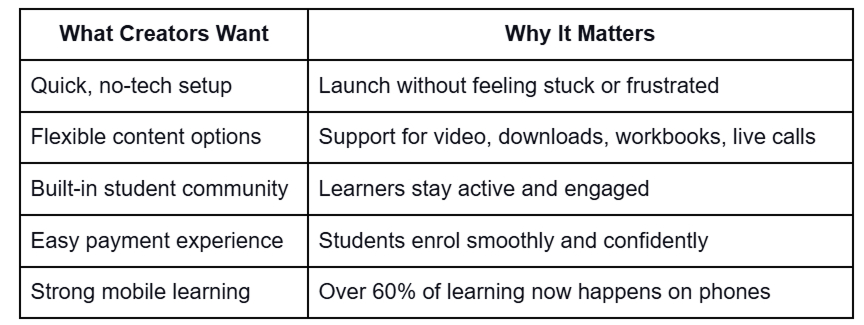The best no-code course platform in 2025 is the one that lets you create and launch your online course effortlessly, but you are not alone if you feel a bit lost while finding it. Many first-time course creators start with enthusiasm, but once they compare platforms, it quickly becomes a mess for them. With every tool claiming to be “all-in-one” or “easy”, how can you be sure which really fits your course and approach?
This article will help you find out what really counts when selecting a no-code course platform, how to choose based on your teaching method, and why the number of creators building, delivering, and growing their courses with confidence on platforms like CustomerHub is increasing, thanks to the support they offer.
Why Are Course Creators Choosing No-Code Platforms in 2025?
In the United States, the number of new course creators has been tremendous, and the trend shows no signs of slowing down. The increased competition has led creators to seek tools that accelerate their launches and keep them teaching throughout the process.

A good context:
• In 2024, 39% of US course creators reported that their launches were delayed due to technical issues.
• Within the first year of switching, 63% said they changed their platforms because their first choice was too technical.
• Course creators who launched within 30 days of starting often earned 2–3× more in their first year than those who spent months setting up.
No-code course platforms let you teach without tech hassle. And this is one of the major reasons why CustomerHub is becoming a favourite: it’s all about making things simple for both creators and learners.
How to Determine Which Platform Suits Your Teaching Style Best?
Before selecting a platform, think about the type of learning experience you would like to offer.

The best no-code course platform in 2025 is the one that makes it easy for you to teach the way you naturally do, rather than imposing a rigid structure on you.
Take a moment to consider the following questions:
• Would you prefer your course to be structured in a step-by-step manner or a more open, guided approach?
• Would your teaching techniques involve worksheets, prompts for reflection, or live calls?
• Would you like your students to communicate only with you or with each other as well?
Here’s something that many new creators miss: your first course need not be perfect, but it should provide a safety net for your students. This usually means having unambiguous steps, a secure environment to raise questions, and a straightforward way to stay involved. CustomerHub helps creators design a course layout that is both inviting and manageable for both creators and students.
Which platforms are considered the best no-code options in 2025?
(CustomerHub vs Others)
When you see the platforms side by side, choosing becomes less of a challenge. Here’s a simple table to assist your thoughts:
The creators who opted for CustomerHub have often commented that it is a peaceful and homely “base” for their course and community rather than a tool that they have to keep figuring out.
Sign up on CustomerHub
What Mistakes Should You Be Careful to Avoid When Selecting a No-Code Platform?
Rushing the decision, along with many other creators, is a common mistake that ends in regret. Here are some possible wrong turnings that you will be able to avoid:
Choosing a popular platform
A popular tool is not automatically the best choice. What may work for a big YouTube creator could be the opposite for a coaching-based, transformation-style course.

Buying into features you are not going to use this time.
Many tools come with elegant features like funnels or automations that novice creators don’t need at their start. Simple works just fine.
Overlooking the student experience
Students finish courses when the platform seems nice and clear, not when it is overwhelming or distracting.
Case Study: A US-based wellness coach said she took 3 weeks to get the hang of her first platform. After she switched to CustomerHub, building her next course took less than 10 days, and more of her students finished it because it was easier to follow.
Learn more about CustomerHub features
How Much Time Should It Take to Create and Publish Your Course?
A reasonable timeline is essential to avoid burnout and self-doubt.
• Traditional DIY with multiple tools: 8–12 weeks
• Standard no-code platform: 2–4 weeks
• With CustomerHub guidance: 7–14 days
The biggest time-saver, according to creators, is not the software but the framework. CustomerHub provides templates and content flow suggestions to guide the creator's launch
with less stress.
What Should Be the Content of Your First Course to Keep Students Interested?
A course does not have to be long in order to be efficient. What is crucial is the clarity, timing, and support given.
A simple 4–6 week structure that is good for beginners:
• Week 1: A simple task that builds confidence
• Week 2: Main lessons at a simple pace
• Week 3: Exercises or application tasks
• Week 4: Live Q&A or support session
• Week 5: Reflection + next steps
Short, friendly, and regular communication. CustomerHub promotes community interactions that increase completion rates without exhausting you.
When Is the Right Time to Incorporate a Membership into Your Course?
A course is the gateway to your online business. A membership is the means by which students can continue to grow alongside you.
You may be ready for a membership when:
• Students ask, “What's next?” after your course
• You want a consistent monthly recurring income
• You want to continue helping students after the first program
A creator based in Chicago introduced a membership after her second course, and 42% of her students agreed to pay for ongoing support. This meant that there was less pressure on the creator to “launch again” every few months.
CustomerHub makes this transition easy because you do not have to switch to another platform; you expand within the same space.
How Does CustomerHub Help Creators Beyond Tech Features?
CustomerHub focuses on support, clarity, and community. Creators appreciate that they don’t feel left to solve everything on their own. You get:
• Templates for course structure
• Ideas for student engagement
• Friendly student experience
• Support during the transition to a membership model
• A peaceful place to build and expand your course
Creators often call CustomerHub “reassuring”, especially when launching for the first time.
Final Remarks: Which Platform Enables You to Build with Certainty?
If you are searching for the best no-code course platform 2025, choose the provider that lets you teach clearly, stay connected with students, and grow at a comfortable—not rushed—pace.
Many creators choose CustomerHub because it supports the entire journey—from your first course to a growing community—in one place that is easy for you and inviting for your students.
If you want a more grounded, supportive way to bring your course to life, CustomerHub offers a calm and guided starting point.

.jpg)



